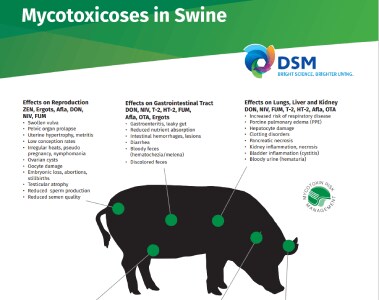Romer Labs, Inc. Analytical Services in Union, MO is converting dsm-firmenich customers using mycotoxin analytical services from the existing multi-mycotoxin LC-MS/MS method (24003000S023) to the updated LC-MS/MS PLUS method (24003000S034). The PLUS method features workflow improvements as well as enhanced sensitivity and has been implemented on samples received by the lab as of August 1, 2023. The following changes are expected as part of the updated PLUS method analysis:
What has changed:
- Harmonized reporting of all toxins in parts per billion (ppb).
- Acetyl-deoxynivalenol, previously reported as a single value, will now be reported separately as 3 Acetyl-Deoxynivalenol and 15 Acetyl-Deoxynivalenol.
- Limits of Detection (LODs) and Limits of Quantitation (LOQs) have decreased for most analytes (see Table 1).
- The LOD and LOQ will be reported per mycotoxin. The following will be reported in the “VALUE” column:
- Results below LOD will be reported as “<LOD”.
- Results higher than LOD, but lower than LOQ will be reported as “<LOQ”.
- Results higher than LOQ will be quantitated with a numeric ppb value.
- Summations by mycotoxin family will be reported including:
- Aflatoxin Total: Aflatoxin B1 + Aflatoxin B2 + Aflatoxin G1 + Aflatoxin G2
- Fumonisin Total: Fumonisin B1 + Fumonisin B2 + Fumonisin B3
- Type B Trich Total: Deoxynivalenol + Nivalenol + Fusarenon X + 3 Acetyl-Deoxynivalenol + 15 Acetyl-Deoxynivalenol
- Type A Trich Total: T-2 Toxin + HT-2 Toxin + Neosolaniol + Diacetoxyscirpenol
- The following values will be used to calculate the summation results reported in the “VALUE” column:
- If a toxin is <LOD, the value included in the summation is set to 0.
- If a toxin is <LOQ, the value included in the summation is set to LOQ/2.
- If a toxin is >LOQ, the value included in the summation is the numeric ppb value.
What has not changed:
- Sample collection procedures and sample submission process remain the same.
- Standard testing turnaround time remains at 5 business days once samples arrive at the lab.
- List prices will not be impacted.
- Results including an interpretation will be sent out via email by dsm-firmenich technical sales managers.
Please contact your dsm-firmenich representative if you have questions about the updated Romer Labs LC-MS/MS Multi-Mycotoxin PLUS method which is now part of the dsm-firmenich mycotoxin analytical service program.
Table 1. Limits of Detection (LOD) and Limits of Quantitation (LOQ) for the Romer Labs LC-MS/MS Multi-Mycotoxin Methods


